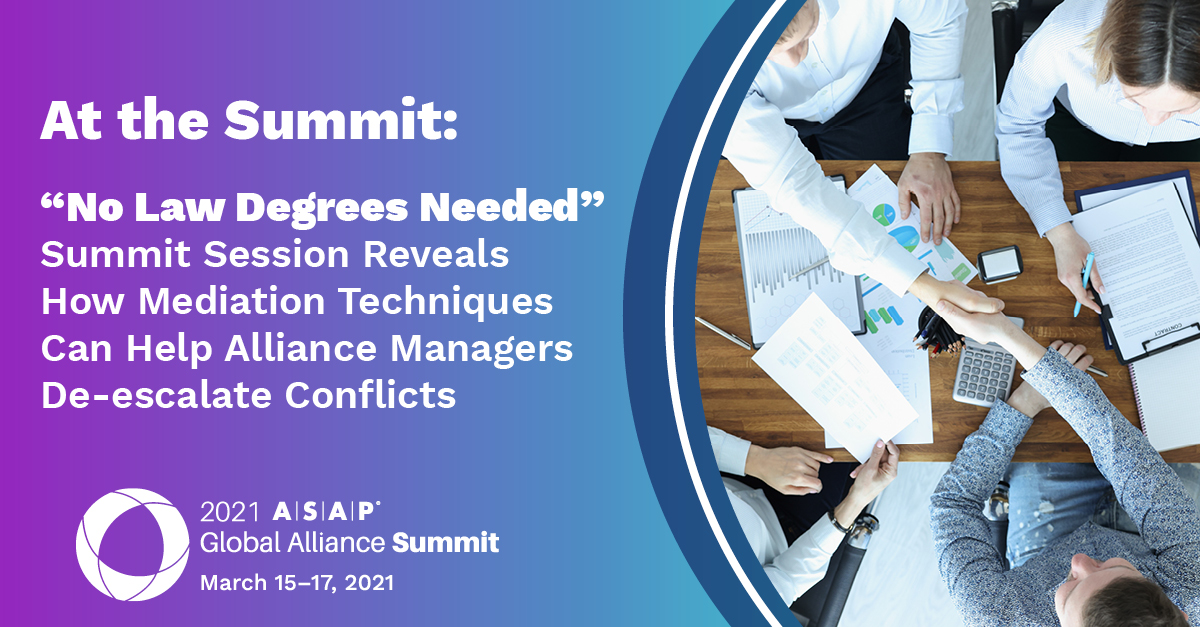“No Law Degrees Needed”
“No Law Degrees Needed”: Summit Session Reveals How Mediation Techniques Can Help Alliance Managers De-escalate Conflicts
Posted By Jon Lavietes, Thursday, April 15, 2021
Updated: Thursday, April 15, 2021
Conflict is endemic to alliances, and thus conflict resolution is one of the alliance manager’s core skills. Regardless of industry, market segment, or company size, issues will crop up in collaborations that pit partners against each other, to some degree. It is so core to the job, The ASAP Handbook of Alliance Management: A Practitioner’s Guide even has a subsection on it.
But what if applying the basic principles of managing conflict doesn’t douse the flames of a conflagration? For instances that call for a more sophisticated approach to resolving differences, two Thomson Reuters legal professionals made the case for using mediation in alliance management in their 2021 ASAP Global Alliance Summit on-demand presentation, “Bringing Down Barriers: Using Alternative Dispute Resolution Techniques to Improve Communication.”
When alliance managers find themselves in situations where tensions are slowly escalating, creating a forum to air out gripes while maintaining a working relationship with minimal rancor can be a balancing act. That’s where mediation comes in; it could be a means for “resolving issues between peers rather than relying on a court system or a formalized process in order to resolve your dispute,” said Ben Anderson, CA-AM, JD, Esq., partner asset and licensing program manager at Thomson Reuters Legal.
And the best part? “No law degrees are needed,” quipped Anderson’s colleague Susan Cleveland, JD, manager of global strategic alliances at Thomson Reuters Legal.
It’s No Surprise: Structure and Transparency Aid Conflict Resolution
Mediation can be a formal process where two parties jointly agree ahead of time on a detailed agenda, through which the stakeholders move systematically through each point. Two big reasons why mediation is so successful, particularly in the US and UK, are that “it adds structure” and it ensures that “both parties are heard,” according to Anderson.
The exercise of putting together the agenda for these formal meetings can help crystallize which issues are at the root of the conflict and which ones are more ancillary. Transparency is paramount, Anderson argued. It is critical to send all relevant data—spreadsheets, financials, product descriptions, etc.—ahead of time under NDA so that everyone is working from the same set of facts.
“This isn’t a courtroom drama with surprise witnesses,” said Anderson. “Surprises detract and distract from the conversation.”
Listen, Pause, Restate…Rinse and Repeat
Mediation techniques can also be less formal. Cleveland provided a few pointers for making a mediation work in a more casual context. The most important one: listen attentively to your counterpart. Don’t just hear what they are saying, understand what they are not mentioning and what that might mean for your collaboration in the big picture.
“It’s obvious, but it is worth calling out,” she said. That’s because in the virtual office it is easy to get distracted by kids, dogs, and your work email. With all of these added disruptions, it can be very useful to pause at various times to make sure everyone is engaged.
For example, Cleveland reminded viewers that Microsoft Teams, Zoom, and other videoconference platforms can have hiccups, and people frequently experience connectivity issues at home. Pausing to make sure that key points are being made and heard can be particularly useful in today’s remote workplace. Restating positions every so often also doesn’t hurt, especially when the parties start to meander into other topics that aren’t core to the issue at hand.
“‘We’re here to discuss issues x, y, z. What I’m hearing is that we may actually need another call for these other points,’” said Cleveland, giving an example of how to make sure a discussion stays on track.
Keeping Well-Intentioned People in the Loop and Bad Actors Out
This led to another important tactic that makes for smoother mediation discussions: looping, the practice of restating the other person’s interest at various points in the conversation to ensure mutual understanding. By stopping to ask questions like, “Is this correct? Am I interpreting this right?” you inherently acknowledge that other people’s positions have been heard, plus you lay the groundwork for getting to the nitty-gritty of a situation when a surface topic is a symptom, not a cause—cases where the issue isn’t the issue, so to speak.
Cleveland mentioned that looping is used in hostage negotiations, but it’s also particularly valuable in alliance settings. She gave the hypothetical example of a company balking at a licensing percentage when the real sticking point might be an underlying IP issue.
Of course, you can’t always assume the other party is reasonable or rational. There will be times when bad actors try to manipulate, apply pressure in, or delay proceedings in a destructive manner. If you determine that the counterpart truly has bad intentions and isn’t just reacting badly to other external factors, there are ways to limit that person’s power to derail the proceedings.
“Maybe it’s an arm’s-length negotiation. It’s just one of those things where you really don’t focus on the truly big picture. Maybe you do have to go redline by redline in order to ensure that nothing is disrupting the process or that undue influence is being exerted,” said Anderson.
“Bringing Down Barriers: Using Alternative Dispute Resolution Techniques to Improve Communication” contained many more great tips for resolving disagreements. Summit registrants, watch the presentation now and discover the five “logical fallacies,” reasoning errors that weaken/invalidate potential arguments, that could be dragging your negotiations down. But hurry, the Summit event portal closes on April 30!

